What yoga record attempt tells us about India
- Published
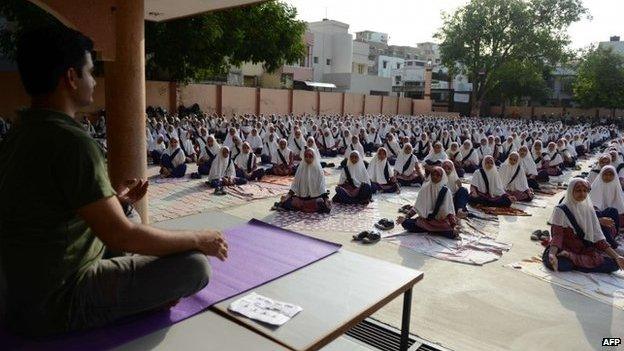
More than 30,000 people are expected to participate in Sunday's gathering in Delhi
India is in the grip of yoga fever, thanks to Prime Minister Narendra Modi.
Mr Modi coaxed the United Nations into declaring 21 June International Yoga Day and announced a grand event to be held in Delhi on that day. His government plans to get tens of thousands of people to perform yoga in the heart of the capital on Sunday.
Mr Modi is an enthusiast himself - he told a biographer he tries to do yoga for an hour after waking up in the morning.
So what does Sunday's mass yoga session tell us about India?

Indians love world records
Mr Modi's plan to get 35,000 people to perform yoga for 35 minutes on the stately Rajpath (King's Avenue) is aimed at setting a new Guinness World Record. The Guinness people have been invited to document the largest yoga class at a single venue.
Indians already flaunt a number of yoga-related world records: the largest yoga class, external, longest yoga chain, external, longest yoga marathon, external and longest yoga class at multiple venues, external.
Inspired by Mr Modi's call, even India's National Cadet Corps want to set another record on Sunday, external - "the largest ever demonstration of yoga by a uniformed organisation on a single day concurrently at multiple venues all across India". It says a million cadets will simultaneously do yoga at 1,900 locations.
Yes, we are crazy about breaking world records.
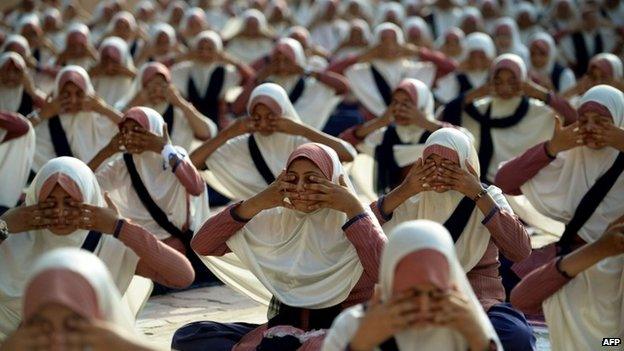
Indians boast a number of world yoga records
A reality check: Indians applied for some 3,000 records with Guinness World Records in 2013, just behind record-seekers from the US and Britain. The number of Indian record holders has risen an astonishing 250% in the past five years.
It helps that we are the world's second-most populous nation, so we have also set records in things like the biggest blood donation drive and most number of people shaking hands. Writer Samanth Subramanian describes this as a "fevered subculture of record-setters"., external
If a place in the Guinness World Records looks remote, no worries. We have our thriving, home-grown Limca Book of World Records, external and India Book of Records, external to take care of our achievements.
But Mr Modi, clearly, has set his sights higher.

Urban Indians are seriously unfit
More seriously, Sunday's gathering is a timely reminder that urban Indians need to get fitter.
Doctors say India's cities are riding a diabetes and heart disease epidemic. India's diabetes rate jumped an alarming 123% between 1990 and 2013, compared to 45% worldwide, a new study, external found. One in four Indians die of heart disease. Obesity is on the rise.
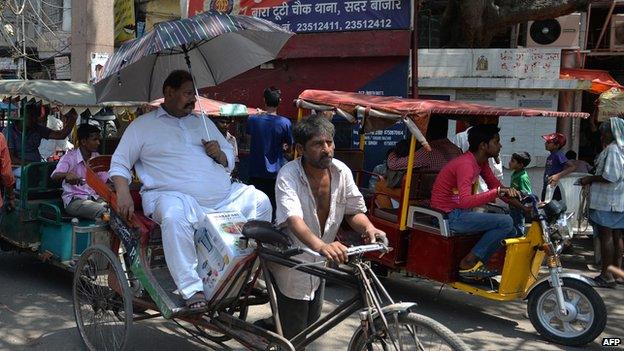
More Indians are leading sedentary lives
As the middle class swells and grows richer, more Indians are leading desk-bound, sedentary work lives and enduring stressful commutes in pedestrian-unfriendly cities, where there is no culture of walking. Gorging on junk food and fat-rich diets doesn't help matters.
If Mr Modi's move encourages more Indians to take to yoga - with or without the spirituality attached to it - it would have served a purpose in making more Indians healthier.

Everything - well, almost - is political
The moment Mr Modi's government unveiled its mega yoga plans, political rivals cried foul.
Mayawati, the feisty leader of India's Dalits (formerly known as untouchables) said Mr Modi's party and its hardline allies were trying to use yoga to "vitiate communal harmony, external".
The main opposition Congress party has taken pot-shots at the event, and a senior party spokesperson issued a snarky broadside:

Some Muslim clerics are uneasy about the government's motives and equate Mr Modi's government's promotion of yoga with promoting Hinduism. A recent story, external by Reuters was headlined: PM Modi's yoga offensive gets Muslims stressed.
Firebrand ruling BJP MP Yogi Adityanath fanned the flames by saying that those who opposed the surya namaskar - a series of yoga positions designed to greet Surya, the Hindu Sun God - "should drown in the sea, external" - a remark that was swiftly put down by Foreign Minister Sushma Swaraj.
The government has even taken out the sun salutation exercise from Sunday's performance, and is very keen to showcase it as secular, external.
Political analyst Neerja Chowdhury says Sunday's event serves the prime minister well. "It's a win-win situation for Mr Modi. It boosts his image and keeps the hardliners happy," she told me.
However, critics say Mr Modi's move comes at a time of rising anxiety among India's minorities, many of whom suspect that his party is trying to make India a pronouncedly Hindu nation.
Analyst Ajaz Ashraf says, external Mr Modi's yoga celebration is a "mix of cultural nationalism, commercialisation and subtle coercion". Historian Dilip Simeon decries what he calls, external the "deceitful polemic about yoga" and says Indians will learn yoga not to please Hindu nationalists, "but for our health".

Cultural anxiety
"Yoga is part of ancient India's cultural heritage," says Manmohan Vaidya, a spokesperson of the Rashtriya Swayamsevak Sangh (RSS), the hardline ideological godfather of the BJP and the largest Hindu nationalist group in India. "By celebrating yoga on a mass scale we are validating our glorious past."
Others say yoga is India's biggest contribution to society after, perhaps, zero and is a symbol of its cultural richness.
There are concerns that India has lost control of "brand yoga" to the West - yoga is a multi-billion dollar industry worldwide - although Foreign Minister Sushma Swaraj has said, external India would "never like an Intellectual Property Rights stamp on yoga".
Is yoga essentially a religious activity? This BBC magazine piece has some answers. But closer to home, the Yoga Day is being seen by many as (Hindu) India "reclaiming" yoga.
Wendy Doniger, leading American academic and author of The Hindus: An Alternative History, says many Hindus, concerned about their image, fear that their religion has been stereotyped in the West as a polytheistic faith of "castes, cows and curry". They look at yoga as the poster-child of Indian spiritual wisdom and the essence of Hinduism.
But this, Doniger believes, ignores yoga's complex and contested history: there are at least five conflicting claims about when yoga began, including a provocative assertion by Mark Singleton, external that the roots of modern yoga actually do not lie in ancient India.
The transnational, Anglophone yoga, Singleton argues, derives from a curious mix of British body-building and physical culture, American transcendentalism, Christian science, naturopathy, Swedish gymnastics and the YMCA. Yoga's appeal grew far and wide. Even Fritz Lang made a film about trippy yogis.
In the end, as Doniger says, "for some people yoga is a religious meditation, for others an exercise routine, and for others, both".
"It is a rich, multi-cultural, interdisciplinary construction, far from the pure line that its adherents often claim for it."

There's never a dull moment
There's no shortage of humour in India - and Sunday's event is no exception.
I think sociologist Shiv Visvanathan puts it best. "[Mr Modi] is looking for a new kind of cultural revolution. I like the comic part of it - the fat cops, the bureaucrats, doing exercise. Here is India, getting fat on hamburgers and milkshakes. Modi is the Benjamin Franklin of India in many ways," he told the New York Times, external.
Even India's Home Minister Rajnath Singh has managed to encourage officials in his office to practice yoga after work, as he keeps a watchful eye on their moves:
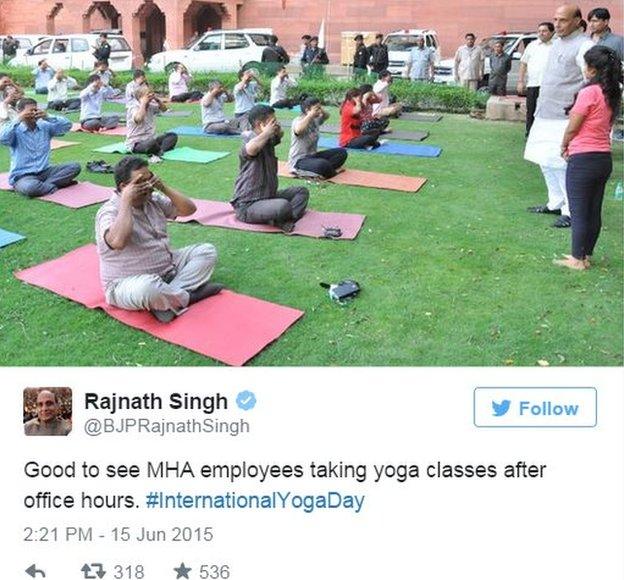
Shripad Naik, the yoga minister, told the New York Times that yoga practice would help lower violent crime and produce better bureaucrats.
"There will be a definite change in the way the bureaucracy functions," he said. "When they are thin, all their energy will go into producing better work."
And popular yoga guru Baba Ramdev told a yoga rehearsal at a Delhi stadium last week that a yoga position would help "rid the world of gas, external".
But this man practising on the soggy rain-soaked field did not quite appear to be listening to the guru's exhortations to put on the world's best yoga show on Sunday.
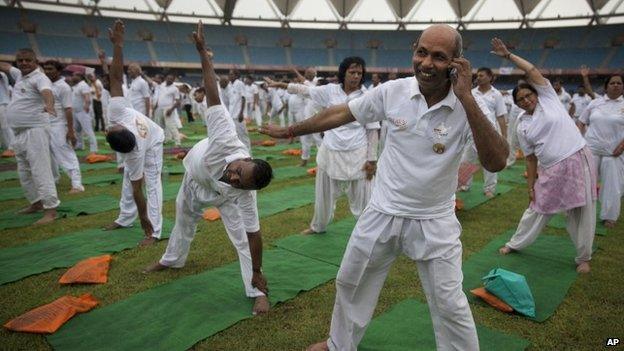
- Published19 June 2015
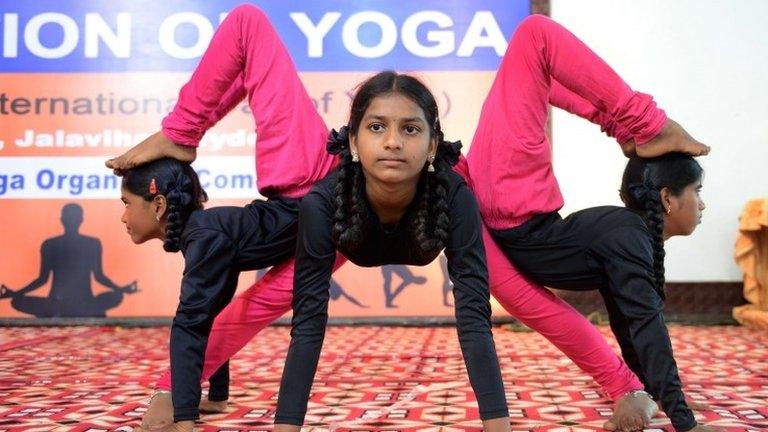
- Published15 June 2015
